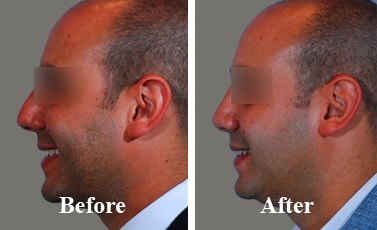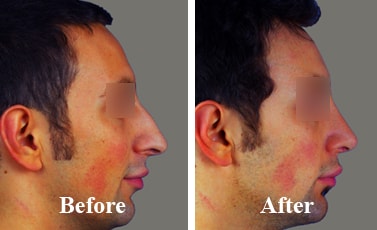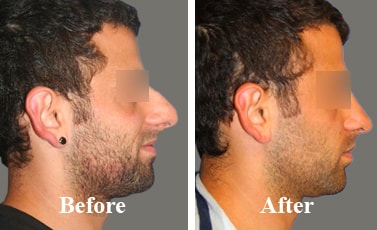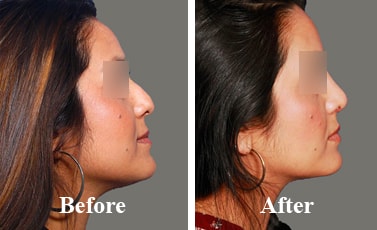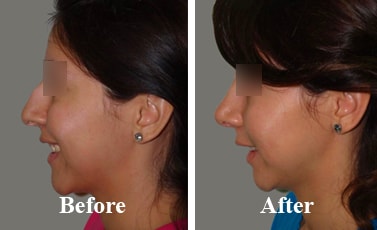Reshape Your Nose As You Want
WhatsApp : 8329060384
Best Rhinoplasty Surgeon in Noida Get Your Nose Reshaped from Best Surgeon!
Rhinoplasty Surgery Clinic in Noida, India - Rhinoplasty, sometimes referred to as a "nose job" or "nose reshaping" by patients is a plastic surgery procedure for correcting and reconstructing the form, restoring the functions, and aesthetically enhancing the nose. Most patients ask to remove a bump, narrow nostril width, change the angle between the nose and the mouth, as well as correct injuries, birth defects, or other problems that affect breathing. Find the best Rhinoplasty Clinic in Noida, India.
[forminator_form id="42596"]
CALL NOW & GET DISCOUNT: 8329060384
Free Consultation, Best Treatment, Lowest Cost, Easy Finance Available, 100% Result
Rhinoplasty Surgery Cost in Noida Know the Cost of Nose Job, Deals & Offers in Noida
Rhinoplasty Cost Depends on?
Nose surgery costs in Noida, India - Rhinoplasty surgery costs can vary widely. The cost of Rhinoplasty Surgery depends on Anesthesia fees, Hospital or surgical facility costs, Medical tests, Post-surgery garments, Prescriptions for medication, Surgeons fee, Clinic stay etc. A surgeons fee will be based on his or her experience and geographic office location. When choosing a board-certified plastic surgeon in your area for a rhinoplasty procedure, remember that the surgeons experience and your comfort with him or her are just as important as the final cost of the surgery.
Fill the form to know the approx cost of Nose surgery for your case in Noida, India.
[forminator_form id="42596"]
Contact Us
[forminator_form id="42596"]
The information on this site is intended for general purposes only and is not intended to nor implied to be a substitute for professional medical advice relative to specific medical conditions or questions. The information on this website is not a guide to treatment, and it should not replace seeking medical advice from your physician. We do not warrant the accuracy, completeness, correctness, timeliness or usefulness of any information contained herein. In no event rhinoplastysurgery.co.in be liable to anyone for any decision made or action taken in reliance upon the information provided through this website. The photos on this website are of models & are not intended to represent the results that every patient can expect. Surgical results vary greatly from patient to patient and are not guaranteed.
Rhinoplasty surgery and its cost in Noida
Second, only to your eyes, your nose is the most prominent feature of your face. The most defining characteristic of your face is the size and shape of your nose. You’re not alone if you are feeling unhappy with your nose. Some people urge to have a nose of a different size or shape. Some people want to breathe easier, while others wish to repair change caused by an injury. You should schedule a consultation with a qualified plastic & cosmetic surgeon if you have been wondering how nose surgery might change your entire personality. Sometimes referred to as “nose reshaping” or a “nose job,” rhinoplasty improves the proportions and appearance of your nose by enhancing self-confidence and facial harmony. Impaired breathing caused by structural abnormalities in the nose can get corrected by nose surgery. The appearance, structure, and function of the nose can be changed by this surgical procedure. To meet the needs of every patient there is no universal type of rhinoplasty. Depending on the patient’s needs rhinoplasty surgery is customized for each of them. Ask your surgeon if there are additional facial procedures that may enhance the effects of your nose surgery before deciding on having a rhinoplasty. To balance their facial features many patients elect to have chin or cheek surgery. There are several clinics and hospitals at Sector 62, Sector 104, Sector 19, Sector 26, Sector 49, Sector 110, Greater Noida West, Sector 27, Sector 11, Sector 30 in Noida for rhinoplasty surgery. The cost of a Rhinoplasty surgery in Noida varies between 50k to 1 Lakh.
The procedure
On an outpatient basis under local or general anaesthesia, the surgery can be performed. Usually, it takes an hour or two to carry out this procedure although it may take longer in a complicated procedure. Most incisions are invisible because they are made inside the nose. Your surgeon sculpts the skin and tissues of the nose along with the underlying bone and cartilage to your desired new shape. The surgical goal decides the technique to be used in the surgery. Inside your nose incisions will be placed. Sometimes while separating the nostrils called the columella a very short incision is made across the vertical strip of tissue. This technique is known as open rhinoplasty. Ultimately the incisions used are very inconspicuous. The cartilages and bone that form the framework of your nose are reshaped through these incisions. Sometimes to make your nose look narrower and straighter the position of certain bones may need to be altered. Your nose can be built up by using a cartilage graft, bone graft or an implant if it needs to. Then over this new framework, the skin and soft tissues re-drape themselves. Small wedges of skin at the base of the nostrils will be removed if the base of the nose is narrowed or the nostrils are reduced. At the joint of nostrils and cheek incisions are hidden in the natural crease.
Expected Results
To see the final result you should expect to wait up to six months or a year since the healing process is gradual. However, within few weeks of your surgery, your new look is visible. Except for possible changes associated with the normal ageing process the results of rhinoplasty are permanent.
Rhinoplasty- Postoperative recommendations
Your surgeon plays an important role throughout the entire process of any surgery (rhinoplasty, mentoplasty , otoplasty, etc). Remember to follow all the instructions provided by your doctor for a faster rhinoplasty recovery and a better end result.
Each patient will experience different intensities of the symptoms described below. Some experience all of the symptoms, while others may experience a portion of them.
Rhinoplasty generally takes two to three weeks to recover, but the entire process can take up to a year. When you experience any symptoms out of the common described by your doctor, call your doctor immediately. There will be some postoperative visits to the doctor, usually included in the price of a rhinoplasty , to monitor the state in which your nose is healing.
Expectations with rhinoplasty surgery
Your surgeon should establish all of your expectations for recovery and give you an idea of how long the recovery process will take.
How long does the recovery take?
Each person recovers differently in terms of time and the healing process. We can give you a general idea of what to expect after rhinoplasty surgery as well as the images you can see of nose surgery before and after . Generally, unlike a hyaluronic acid rhinoplasty , the average recovery time is two to three weeks. Please note that the time may vary from patient to patient depending on the extent of the surgery and other factors.
How long is the postoperative period and how is it?
The surgery lasts between one and a few hours, and you are usually allowed to go home the same day.
Immediately after surgery, you will be taken to a recovery room until you wake up from general anesthesia and then you can have someone drive you home.
Depending on how your body reacts to the anesthesia, you may have some nausea immediately after the procedure.
You will feel discomfort, congestion, tiredness, and tenderness in and around your nose as well. Other common symptoms are pain, swelling, and discharge from the nose.
You won't be able to blow your nose for about a week after surgery. Blowing your nose can interrupt the healing process and can even reopen incisions that were made during surgery.
Postoperative open or closed rhinoplasty: how is the recovery process?
Nose recovery after rhinoplastyYou will experience a mild to moderate amount of pain and discomfort associated with the surgery. This should be easily controlled with oral pain relievers.
Discomfort and pain should begin to subside within 72 hours after surgery. If a significant increase in pain is noted after this period of time, the surgeon should be contacted.
Bruising and swelling are not unusual after surgery. These symptoms often get worse on the second day after surgery and then steadily improve afterward; this is normal.
The amount of bruising that occurs varies significantly from person to person. Most of the swelling occurs around the eyes , but some bruising can localize and discolor the cheek area.
If only the septum is operated (due to a deviated nasal septum , for example) and / or the nasal tip, then mild bruising is usually expected, should it occur.
Expect some bloody nasal discharge after any nasal surgery. Usually, at the end of the surgery, light tape and a plastic nasal dressing are placed on the outside under the nose , and plastic splints are placed on the inside. Expect that during the first 24-48 hours, this dressing will be changed several times.
If only a septoplasty and / or nasal tip surgery has been performed, the external dressing can be omitted.
Remove the internal nasal splint and dressings remove the external nasal splint from rhinoplasty
The internal splints and plastic dressing are removed 5 to 7 days after surgery.
Both internal and external nasal dressings are removed in 5-7 days after surgery.
Nasal congestion is the most annoying problem that usually occurs after surgery.
It is most stressful in the first week after surgery and improves significantly once the internal nasal splints are removed.
Any residual congestion can be expected to improve gradually over a period of several weeks thereafter.
Excess mucus is often present in the throat after surgery. It is because splints inside the nose stimulate the nose to temporarily produce more mucus than normal . This problem will resolve once the splints are removed (5 to 7 days after surgery).
The numbness in the tip of the nose , upper front teeth or the palate after surgery is expected because nasal surgery typically causes a temporary interruption of some of the nerves in the area. The sensitivity will generally return slowly over a period of several weeks and, rarely, months.
A temporary decrease or alteration in the sense of smell or taste is common after surgery. This is, again, secondary to the interruption of some nerves in the nose during surgery. These changes will begin to improve within the first 1 to 2 weeks after the procedure.
It is very important to be aware of the fact that the swelling from surgery will temporarily make the nose appear wider and the tip higher and less refined than intended. It will often be noticed that the swelling at the bridge of the nose will improve more quickly than the swelling at the tip of the nose. This should not be a cause for alarm.
All swelling in the nose will improve greatly in the first few weeks after surgery. Although much of the swelling will have resolved within a few months, the nose will continue to improve for up to a year after surgery. Patients who have had only septum surgery usually do not have any significant swelling on the outside of the nose.
Common symptoms after the operation.
Swelling
swelling and numbness in postoperative nose jobThe swelling can vary from patient to patient. In reality, the swelling may increase for the first three to four days before subsiding. When the splint is removed within a week, your nose may appear fat and oily, which is to be expected.
Most of your swelling will go away in the first two to three weeks. However, expect to have minor fluctuations in the remaining swelling over the course of the next two to three months
Steps to minimize this swelling include keeping your head elevated as much as possible for the first two to three weeks, avoiding bending or lifting heavy objects for the first three weeks, and avoiding prolonged exposure to the sun for the first two to three months.
Discoloration and bruising
Bruises can vary like swelling from one person to another. Most of the bruising and discoloration will disappear in the first two weeks.
The makeup , with the permission of your surgeon may apply ten days to two weeks after surgery.
Numbness
Your nose will be numb after surgery. This is normal and will decrease in the next few weeks or months. Unusual sensations, pricks and needles, and occasionally mild discomfort can occur as these nerves regenerate over time.
Bleeding
If bleeding occurs , lie down with your head elevated, try to relax, and take a pain reliever if desired. Put cold compresses on your eyes just as you did after surgery. You can apply light pressure to each side of your nose and wait 15 minutes. If bleeding persists at this point, contact your surgeon.
Depression
It is not uncommon for patients to go through a period of mild depression after cosmetic surgery.
This usually occurs the second week after surgery, while some of the swelling and bruising still persists and yet the patient is eager to see a final result.
Realize that this is a temporary condition and that things will get better. Focus on diligently pursuing wound care and other activities to help divert your mind.
Eye glasses
Glasses can be worn with the splint in place. Once the splint is removed, they must be suspended from the forehead or supported on the cheek for a period of six weeks. This is important - pressure on the nose can change its final shape. Contact lenses can be placed a week after surgery.
Tips for Rhinoplasty Recovery
Now that you understand some of the more common symptoms, here are some tips you can follow to aid your recovery.
- Rest is one of the most essential parts your body needs to recover after rhinoplasty surgery . Resting as often as possible will be of great help during recovery. When you rest, try to keep your head in an elevated position to avoid putting pressure on your nose.
- It is also important to stay hydrated , which will decrease pain and increase your healing rate.
- Putting ice packs or cold packs on your eyes and nose for 15 minutes at a time for up to 3 days can speed up the reduction of swelling.
- Avoid any strenuous activity or playing any contact sport.
- If you are a smoker, try to avoid smoking because it can delay and damage the healing process.
- Although you can return to your normal activities in about two weeks, your nose can be very sensitive for longer. Minor swelling and tenderness can sometimes take a few months or even a year to fully heal.
Other care during recovery
- Do not exercise vigorously for at least two weeks.
- Do not lift heavy objects for three weeks.
- Wear button-down or zip-up shirts to avoid pulling them over your head for two weeks.
- Avoid chewing hard food for two weeks.
- Avoid yawning or opening your mouth wide for two weeks.
- Avoid blowing your nose or inhaling through your nose for two weeks.
- Use a baby toothbrush on your upper teeth for two weeks after surgery.
- For two weeks, if you sneeze, sneeze with your mouth open.
- Do not drive for a week , preferably two weeks after surgery.
- No contact sports for six weeks.
- Day-to-day recovery schedule after rhinoplasty
The approximate recovery after rhinoplasty is as follows:
- DAY 1 Return home. Use cold compresses for 24 hours. Some swelling and bruising, slight discomfort. Change the mustache bandage as needed (often 10-20 times).
- DAY 2-3 Maximum bruising and swelling.
- DAYS 5-14 Remove or dissolve external spots. Internal and external nasal dressings removed by the surgeon. The bruises disappear.
- WEEK 2-4 Much of the swelling has started to go away. You will breathe better.
- 1 YEAR Enjoy your final result
